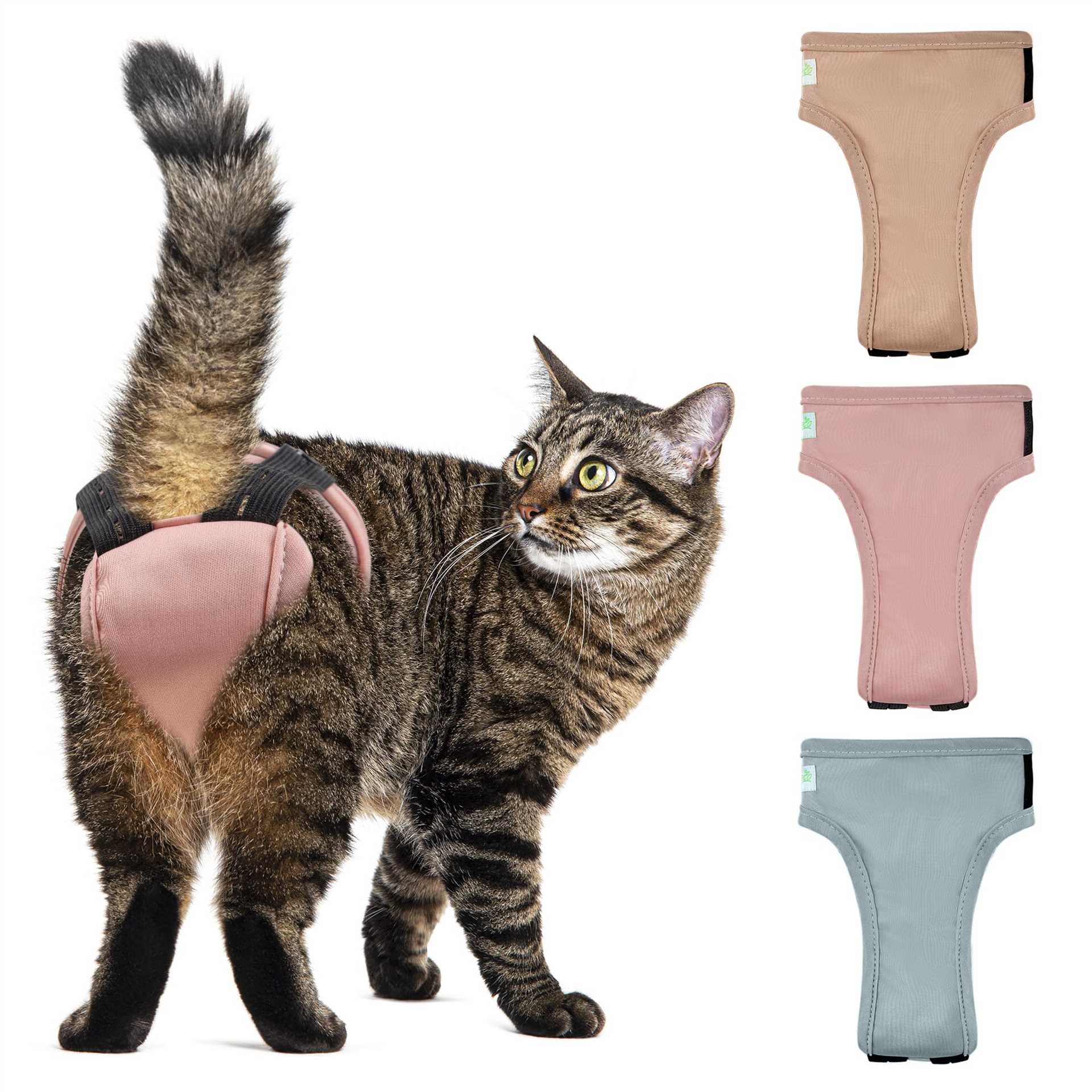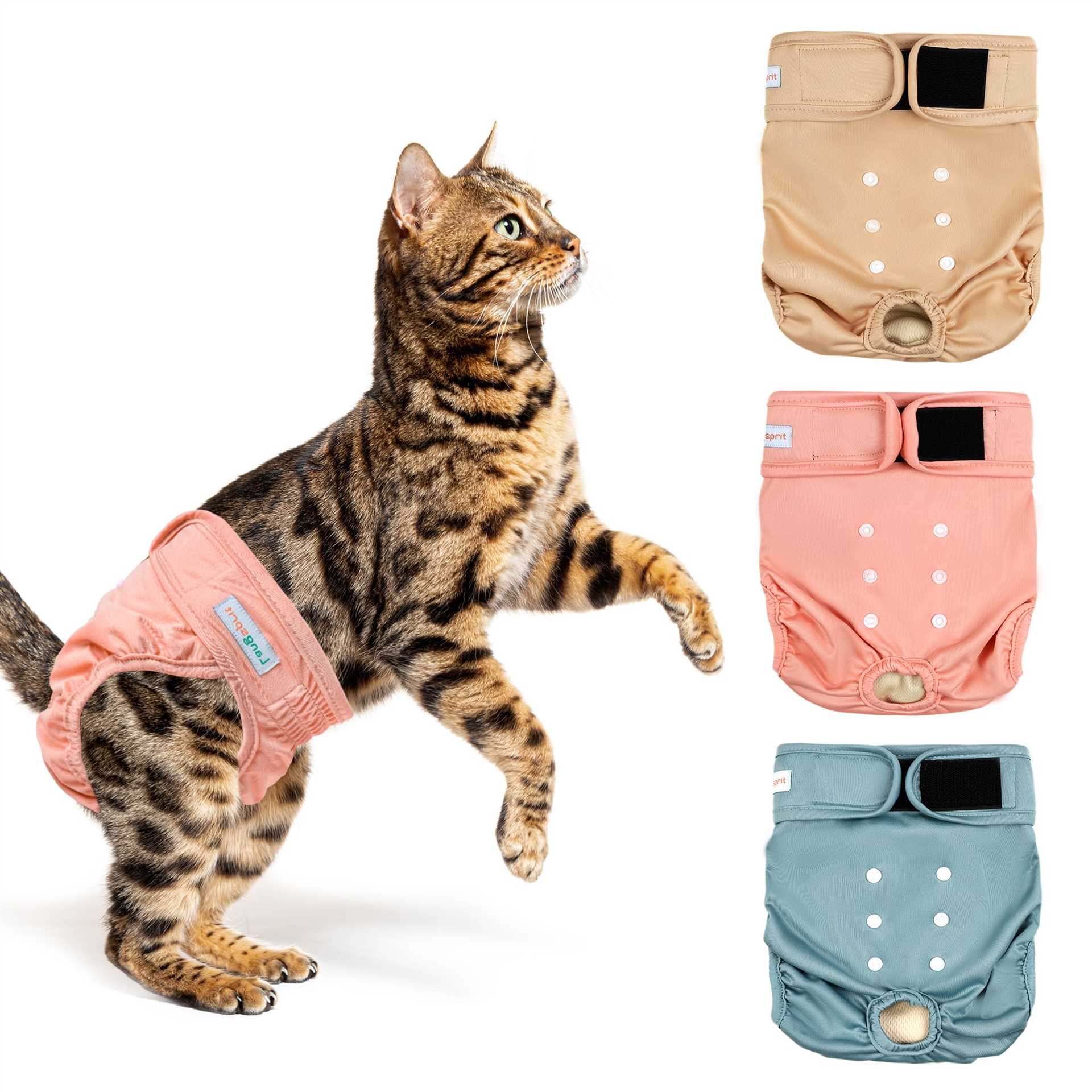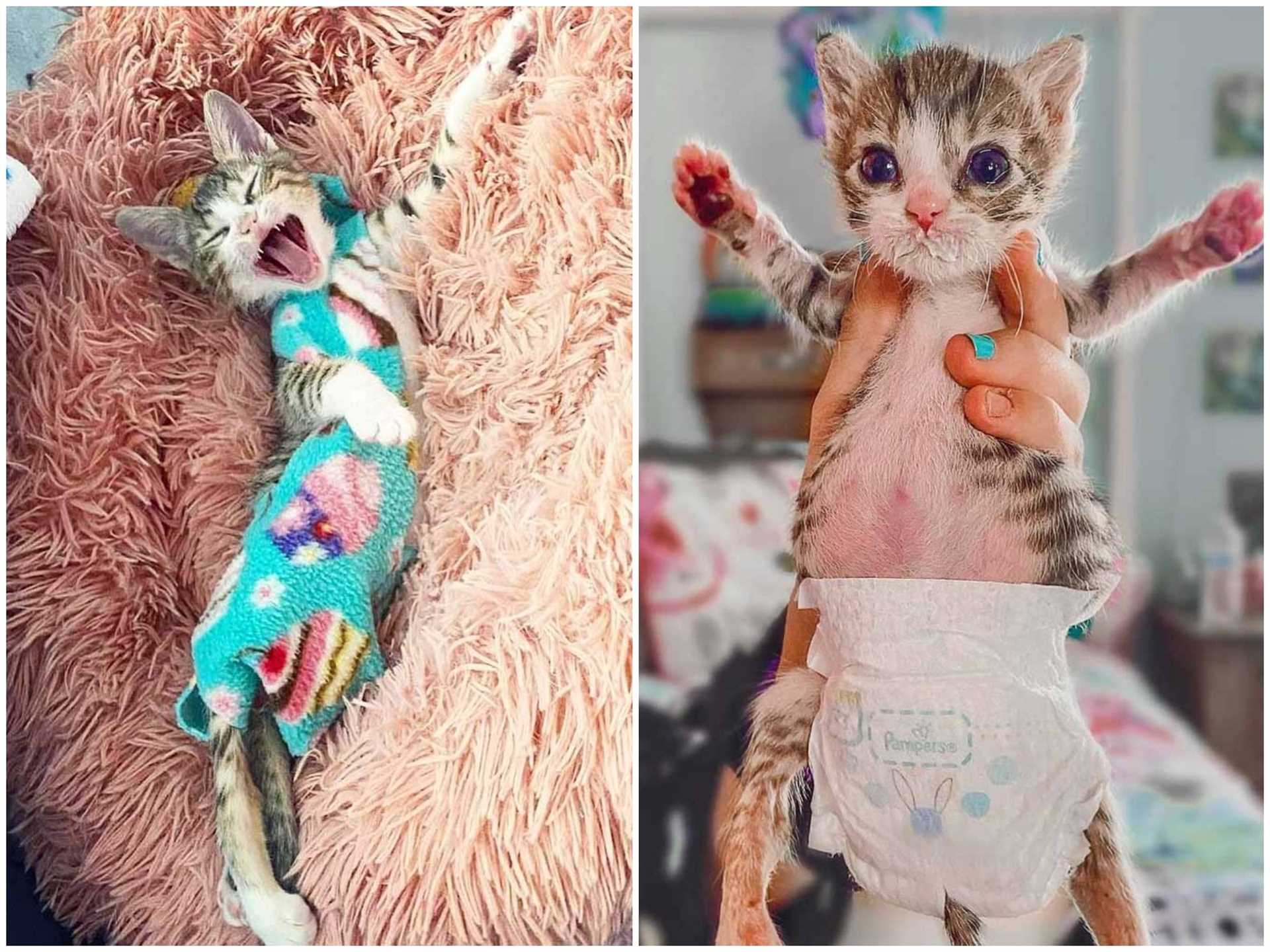Absolutely! It’s possible for furry companions like me to sport a protective garment designed for those little accidents. These items can be particularly helpful for senior felines or those with health issues that affect their bathroom habits.
When considering this option, it’s crucial to choose the right size and style to ensure comfort. Look for products that are specifically designed for our unique body shapes. A well-fitting alternative will allow for movement without causing irritation.
Introduce the idea gradually. Let your pet sniff and explore the garment before attempting to put it on. A few treats can make this experience more enjoyable. Once it’s on, monitor how your companion reacts. If there’s significant discomfort, it might be wise to try another brand or design.
Regularly check the fit and cleanliness. Changing the garment frequently will help maintain hygiene and keep your furry friend comfortable. After all, keeping your buddy happy is the ultimate goal!
Can Felines Utilize Absorbent Garments?
Absolutely! Many companions like me can benefit from the use of absorbent garments, especially in specific situations. Here are some scenarios where these products can be helpful:
- Medical Recovery: Following surgery or during recovery from illness, these items can prevent messes and keep the environment clean.
- Senior Companions: Older companions with mobility issues or incontinence can stay comfortable and avoid accidents around the house.
- Traveling: Road trips or visits to unfamiliar places can lead to anxiety. Having a protective layer can help keep things tidy.
Choosing the Right Fit
It’s important to select the proper size and type to ensure comfort. Here are tips to keep in mind:
- Measure the waist and length accurately to find the best fit.
- Opt for breathable materials to avoid irritation.
- Look for adjustable options for a snug yet comfortable fit.
Introducing the Concept
Gradual introduction is key. Start with short periods, allowing time to adjust. Reward positive behavior with treats and affection to create a positive association. Patience is essential as some might take longer to adapt.
Choosing the Right Diaper Size for Your Feline Friend
For a snug fit, measure around the widest part of the body, typically just in front of the back legs. This measurement will guide you in selecting the appropriate size. Each brand has its own sizing chart, so refer to it closely.
Ensure the option chosen is not too tight, which could cause discomfort or restrict movement. Conversely, a loose fit may lead to leaks and messes. A good rule is to allow enough space to fit one or two fingers between the diaper and the skin.
Experimenting with different styles is beneficial. Some designs feature adjustable tabs, allowing for a more customized fit. If your companion is particularly active, look for options labeled as “active fit” or “stay-dry.”
Keep an eye on the signs of irritation or discomfort. If your furry friend seems restless or is grooming excessively, the size might need adjustment. Regular changes are essential to maintain comfort and hygiene.
In addition to proper sizing, hygiene management is important. Check out this link for tips on how to reduce cat smell in house. Maintaining a clean environment contributes to the overall well-being of your beloved pet.
How to Train Your Feline Friend to Use a Diaper

First things first, introduce the concept gradually. Allow your furry companion to sniff and explore the diaper without any pressure. This helps them get used to the new item in their environment.
Positive Reinforcement
Use treats and praise whenever your buddy interacts with the diaper. Start by rewarding them for simply approaching it. Gradually, encourage them to step inside it. Always keep the mood light and fun.
Short Sessions
Begin with short periods of wearing the diaper. Monitor their comfort and gradually extend the duration. It’s essential to ensure they don’t feel confined. If they show signs of distress, take a step back and try again later.
While training, ensure the diaper fits properly. An ill-fitting product can cause discomfort and anxiety. If your buddy struggles with the concept, check for any potential irritations or discomforts. For those curious about my breed, you can find out how much does a british blue cat cost.
Consistency is key. Repeating the process daily helps reinforce the behavior. Patience and understanding go a long way in making this transition smooth. Always prioritize your companion’s comfort and happiness during training.
Cleaning and Maintaining Feline Hygiene Garments

After a long day of lounging and napping, I know how important it is to keep my hygiene gear in pristine condition. Regular washing is key. Most options are machine washable, but always check the label for specific instructions. I prefer cold water to preserve the fabric, followed by a gentle cycle. Avoid fabric softeners; they can reduce absorbency.
Drying Techniques
Air drying works best. Just hang them up, and let nature do its thing. If you must use a dryer, opt for a low heat setting to prevent damage. Always ensure they’re completely dry before the next use to avoid any unpleasant odors.
Spot Cleaning Tips

For minor accidents, a quick rinse with cool water can do wonders. Use a mild detergent if necessary, and always rinse thoroughly. Keeping a designated cleaning kit nearby makes the process smoother–just some wipes, a small spray bottle, and a cloth will suffice.
Video:
Absolutely! It’s possible for furry companions like me to sport a protective garment designed for those little accidents. These items can be particularly helpful for senior felines or those with health issues that affect their bathroom habits.
When considering this option, it’s crucial to choose the right size and style to ensure comfort. Look for products that are specifically designed for our unique body shapes. A well-fitting alternative will allow for movement without causing irritation.
Introduce the idea gradually. Let your pet sniff and explore the garment before attempting to put it on. A few treats can make this experience more enjoyable. Once it’s on, monitor how your companion reacts. If there’s significant discomfort, it might be wise to try another brand or design.
Regularly check the fit and cleanliness. Changing the garment frequently will help maintain hygiene and keep your furry friend comfortable. After all, keeping your buddy happy is the ultimate goal!
Can Felines Utilize Absorbent Garments?
Absolutely! Many companions like me can benefit from the use of absorbent garments, especially in specific situations. Here are some scenarios where these products can be helpful:
- Medical Recovery: Following surgery or during recovery from illness, these items can prevent messes and keep the environment clean.
- Senior Companions: Older companions with mobility issues or incontinence can stay comfortable and avoid accidents around the house.
- Traveling: Road trips or visits to unfamiliar places can lead to anxiety. Having a protective layer can help keep things tidy.
Choosing the Right Fit
It’s important to select the proper size and type to ensure comfort. Here are tips to keep in mind:
- Measure the waist and length accurately to find the best fit.
- Opt for breathable materials to avoid irritation.
- Look for adjustable options for a snug yet comfortable fit.
Introducing the Concept
Gradual introduction is key. Start with short periods, allowing time to adjust. Reward positive behavior with treats and affection to create a positive association. Patience is essential as some might take longer to adapt.
Choosing the Right Diaper Size for Your Feline Friend
For a snug fit, measure around the widest part of the body, typically just in front of the back legs. This measurement will guide you in selecting the appropriate size. Each brand has its own sizing chart, so refer to it closely.
Ensure the option chosen is not too tight, which could cause discomfort or restrict movement. Conversely, a loose fit may lead to leaks and messes. A good rule is to allow enough space to fit one or two fingers between the diaper and the skin.
Experimenting with different styles is beneficial. Some designs feature adjustable tabs, allowing for a more customized fit. If your companion is particularly active, look for options labeled as “active fit” or “stay-dry.”
Keep an eye on the signs of irritation or discomfort. If your furry friend seems restless or is grooming excessively, the size might need adjustment. Regular changes are essential to maintain comfort and hygiene.
In addition to proper sizing, hygiene management is important. Check out this link for tips on how to reduce cat smell in house. Maintaining a clean environment contributes to the overall well-being of your beloved pet.
How to Train Your Feline Friend to Use a Diaper

First things first, introduce the concept gradually. Allow your furry companion to sniff and explore the diaper without any pressure. This helps them get used to the new item in their environment.
Positive Reinforcement
Use treats and praise whenever your buddy interacts with the diaper. Start by rewarding them for simply approaching it. Gradually, encourage them to step inside it. Always keep the mood light and fun.
Short Sessions
Begin with short periods of wearing the diaper. Monitor their comfort and gradually extend the duration. It’s essential to ensure they don’t feel confined. If they show signs of distress, take a step back and try again later.
While training, ensure the diaper fits properly. An ill-fitting product can cause discomfort and anxiety. If your buddy struggles with the concept, check for any potential irritations or discomforts. For those curious about my breed, you can find out how much does a british blue cat cost.
Consistency is key. Repeating the process daily helps reinforce the behavior. Patience and understanding go a long way in making this transition smooth. Always prioritize your companion’s comfort and happiness during training.
Cleaning and Maintaining Feline Hygiene Garments

After a long day of lounging and napping, I know how important it is to keep my hygiene gear in pristine condition. Regular washing is key. Most options are machine washable, but always check the label for specific instructions. I prefer cold water to preserve the fabric, followed by a gentle cycle. Avoid fabric softeners; they can reduce absorbency.
Drying Techniques
Air drying works best. Just hang them up, and let nature do its thing. If you must use a dryer, opt for a low heat setting to prevent damage. Always ensure they’re completely dry before the next use to avoid any unpleasant odors.
Spot Cleaning Tips

For minor accidents, a quick rinse with cool water can do wonders. Use a mild detergent if necessary, and always rinse thoroughly. Keeping a designated cleaning kit nearby makes the process smoother–just some wipes, a small spray bottle, and a cloth will suffice.
Video:
Absolutely! It’s possible for furry companions like me to sport a protective garment designed for those little accidents. These items can be particularly helpful for senior felines or those with health issues that affect their bathroom habits.
When considering this option, it’s crucial to choose the right size and style to ensure comfort. Look for products that are specifically designed for our unique body shapes. A well-fitting alternative will allow for movement without causing irritation.
Introduce the idea gradually. Let your pet sniff and explore the garment before attempting to put it on. A few treats can make this experience more enjoyable. Once it’s on, monitor how your companion reacts. If there’s significant discomfort, it might be wise to try another brand or design.
Regularly check the fit and cleanliness. Changing the garment frequently will help maintain hygiene and keep your furry friend comfortable. After all, keeping your buddy happy is the ultimate goal!
Can Felines Utilize Absorbent Garments?
Absolutely! Many companions like me can benefit from the use of absorbent garments, especially in specific situations. Here are some scenarios where these products can be helpful:
- Medical Recovery: Following surgery or during recovery from illness, these items can prevent messes and keep the environment clean.
- Senior Companions: Older companions with mobility issues or incontinence can stay comfortable and avoid accidents around the house.
- Traveling: Road trips or visits to unfamiliar places can lead to anxiety. Having a protective layer can help keep things tidy.
Choosing the Right Fit
It’s important to select the proper size and type to ensure comfort. Here are tips to keep in mind:
- Measure the waist and length accurately to find the best fit.
- Opt for breathable materials to avoid irritation.
- Look for adjustable options for a snug yet comfortable fit.
Introducing the Concept
Gradual introduction is key. Start with short periods, allowing time to adjust. Reward positive behavior with treats and affection to create a positive association. Patience is essential as some might take longer to adapt.
Choosing the Right Diaper Size for Your Feline Friend
For a snug fit, measure around the widest part of the body, typically just in front of the back legs. This measurement will guide you in selecting the appropriate size. Each brand has its own sizing chart, so refer to it closely.
Ensure the option chosen is not too tight, which could cause discomfort or restrict movement. Conversely, a loose fit may lead to leaks and messes. A good rule is to allow enough space to fit one or two fingers between the diaper and the skin.
Experimenting with different styles is beneficial. Some designs feature adjustable tabs, allowing for a more customized fit. If your companion is particularly active, look for options labeled as “active fit” or “stay-dry.”
Keep an eye on the signs of irritation or discomfort. If your furry friend seems restless or is grooming excessively, the size might need adjustment. Regular changes are essential to maintain comfort and hygiene.
In addition to proper sizing, hygiene management is important. Check out this link for tips on how to reduce cat smell in house. Maintaining a clean environment contributes to the overall well-being of your beloved pet.
How to Train Your Feline Friend to Use a Diaper

First things first, introduce the concept gradually. Allow your furry companion to sniff and explore the diaper without any pressure. This helps them get used to the new item in their environment.
Positive Reinforcement
Use treats and praise whenever your buddy interacts with the diaper. Start by rewarding them for simply approaching it. Gradually, encourage them to step inside it. Always keep the mood light and fun.
Short Sessions
Begin with short periods of wearing the diaper. Monitor their comfort and gradually extend the duration. It’s essential to ensure they don’t feel confined. If they show signs of distress, take a step back and try again later.
While training, ensure the diaper fits properly. An ill-fitting product can cause discomfort and anxiety. If your buddy struggles with the concept, check for any potential irritations or discomforts. For those curious about my breed, you can find out how much does a british blue cat cost.
Consistency is key. Repeating the process daily helps reinforce the behavior. Patience and understanding go a long way in making this transition smooth. Always prioritize your companion’s comfort and happiness during training.
Cleaning and Maintaining Feline Hygiene Garments

After a long day of lounging and napping, I know how important it is to keep my hygiene gear in pristine condition. Regular washing is key. Most options are machine washable, but always check the label for specific instructions. I prefer cold water to preserve the fabric, followed by a gentle cycle. Avoid fabric softeners; they can reduce absorbency.
Drying Techniques
Air drying works best. Just hang them up, and let nature do its thing. If you must use a dryer, opt for a low heat setting to prevent damage. Always ensure they’re completely dry before the next use to avoid any unpleasant odors.
Spot Cleaning Tips

For minor accidents, a quick rinse with cool water can do wonders. Use a mild detergent if necessary, and always rinse thoroughly. Keeping a designated cleaning kit nearby makes the process smoother–just some wipes, a small spray bottle, and a cloth will suffice.









